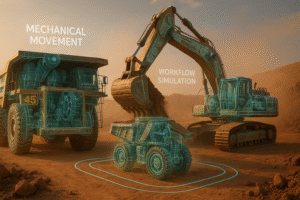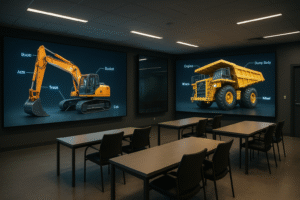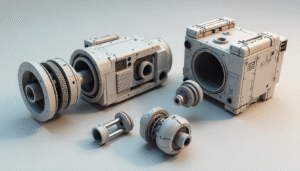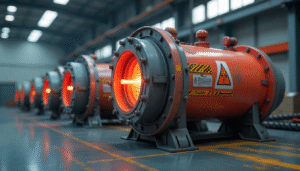In today’s digital landscape, industrial 3D animation is revolutionizing how businesses present their ideas, products, and processes. Whether it’s for marketing, training, or product demonstrations, 3D animation provides a compelling and visually engaging way to communicate complex information. But what exactly makes industrial 3D animation so powerful, and why should companies invest in it? This guide explores the benefits, applications, and best practices of 3D animation for industrial purposes.
The Power of Industrial 3D Animation
Visual Storytelling for Better Understanding
Industrial processes can be intricate and difficult to explain using static images or text-heavy documents. 3D animation simplifies these complexities by breaking down workflows into engaging, digestible visuals. By leveraging motion, textures, and simulations, businesses can showcase their products and services in an easy-to-understand format.
Engaging and Persuasive Presentations
Compared to traditional presentations, animated videos keep audiences engaged by stimulating visual and auditory senses. Whether it’s a product demo or a training video, 3D animation ensures that viewers retain information more effectively.
Boosting Brand Perception and Credibility
High-quality animations make a business appear more professional and innovative. A well-executed animation reflects expertise and attention to detail, helping companies build trust with potential clients and stakeholders.
Industries That Benefit from 3D Animation
Manufacturing and Engineering
3D animations allow manufacturers to demonstrate machinery, production processes, and assembly lines without requiring physical prototypes. This helps streamline communication with clients and investors.

Construction and Architecture
Architectural firms use 3D animations to create realistic walkthroughs and flyovers of building projects, providing clients with a clear vision of the final structure before construction begins.
Oil, Gas, and Energy
Explaining the intricacies of oil extraction, refining, and energy distribution can be challenging. 3D animation simplifies these processes for training and educational purposes.

Automotive and Aerospace
From aerodynamics simulations to virtual crash tests, 3D animations help manufacturers visualize and optimize their designs before production.
Medical and Pharmaceutical
Medical professionals and pharmaceutical companies use 3D animations to illustrate medical procedures, drug interactions, and device mechanisms with unparalleled clarity.
Key Elements of a High-Quality Industrial 3D Animation
Realism and Attention to Detail
Animations must be as close to reality as possible, using high-resolution textures, precise models, and accurate simulations.
Accurate Motion and Physics
To maintain credibility, animations should adhere to real-world physics, ensuring that movements, interactions, and mechanics look natural.
Seamless Storytelling and Narration
A compelling story enhances the viewer’s engagement. The animation should have a clear purpose, whether it’s educating an audience or promoting a product.
High-Quality Lighting and Rendering
Proper lighting enhances realism and ensures that key elements stand out. Advanced rendering techniques improve the final visual output.
The Role of 3D Animation in Marketing and Sales
Enhancing Product Demonstrations
A well-crafted 3D animation can showcase a product’s functionality and features far better than a traditional sales pitch.
Supporting Digital Marketing Campaigns
From social media ads to YouTube videos, 3D animations drive engagement and SEO rankings, leading to increased visibility and conversions.
Trade Shows and Exhibitions
Businesses use 3D animations at trade shows to create eye-catching presentations that attract visitors and generate leads.

Cost vs. ROI: Is 3D Animation Worth the Investment?
Comparing Traditional Media vs. 3D Animation
While traditional video production requires live actors, sets, and props, 3D animation eliminates these costs while providing greater creative flexibility.
Long-Term Benefits of 3D Animation
3D animations can be repurposed across multiple platforms, including websites, presentations, and social media, maximizing their return on investment.
Steps to Create an Industrial 3D Animation
Defining the Project Scope and Goals
Identify the target audience, key messages, and objectives to ensure the animation aligns with business goals.
Storyboarding and Concept Development
Creating a storyboard helps map out the animation’s structure, sequence, and narrative flow before production begins.
Modeling and Texturing
Using specialized software, 3D artists create detailed models of machines, products, or environments and apply realistic textures.
Animation and Rigging
Animating objects involves adding motion and interactions to bring the scene to life, often using physics-based simulations.
Rendering and Post-Production
The final step includes lighting adjustments, camera angles, and rendering the animation into a high-quality format.
Choosing the Right 3D Animation Studio
Factors to Consider When Hiring an Animation Studio
Look for experience, portfolio quality, and client testimonials when selecting a 3D animation service provider.
Comparing In-House vs. Outsourced 3D Animation
While in-house teams provide more control, outsourcing to specialized studios often delivers higher-quality results at a lower cost.
How to Ensure High-Quality Deliverables
Clearly communicate your vision, provide detailed feedback, and review progress at each stage of the project.
Conclusion
Industrial 3D animation is an invaluable tool for businesses looking to captivate audiences, simplify complex ideas, and elevate brand perception. With its applications spanning multiple industries, 3D animation is no longer a luxury but a necessity for companies aiming to stay ahead of the competition. Investing in high-quality 3D animation ensures better engagement, stronger marketing impact, and ultimately, increased sales and customer trust.
FAQs
Q1: How long does it take to create an industrial 3D animation?
A: The timeline depends on complexity but typically ranges from 2 to 8 weeks.
Q2: Is 3D animation expensive?
A: Costs vary, but high-quality animations offer significant ROI in marketing and sales.
Q3: Can 3D animations be used for training purposes?
A: Yes! Many industries use them for training and safety demonstrations.
Q4: What software is used for industrial 3D animation?
A: Popular tools include Blender, Cinema 4D, Autodesk Maya, and 3ds Max.
Q5: How do I ensure my 3D animation aligns with my brand identity?
A: Work closely with the animation studio to maintain consistency in colors, style, and messaging.






